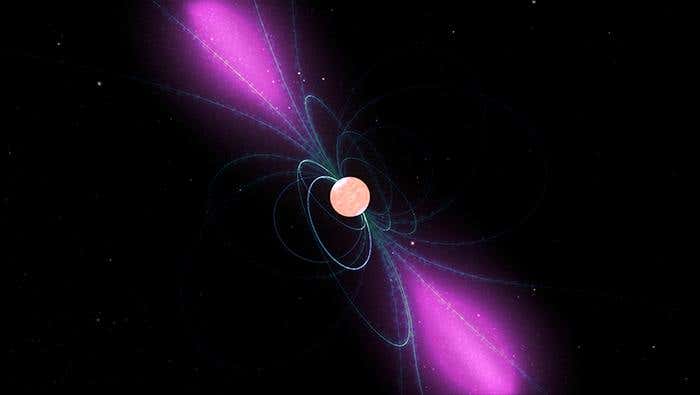Scientists detect the most energetic cosmic-rays ever observed
H.E.S.S. Observatory’s data reveal a sharp break in cosmic-ray electron energies, narrowing origins to local sources and advancing astrophysics.

Artist’s impression of a pulsar with its powerful magnetic field rotating around it. The clouds of charged particles moving along the field lines emit gamma rays that are focused by the magnetic fields, rather like the beams of light from a lighthouse. In these magnetic fields, pairs of positrons and electrons are created and accelerated, making pulsars potential sources of high-energy cosmic electrons and positrons. (CREDIT: NASA/Goddard Space Flight Center Conceptual Image Lab)
High-energy particles, known as cosmic rays, provide a window into some of the most extreme environments in the universe. These particles, particularly cosmic-ray electrons (CRe) and positrons, are accelerated to extraordinary energies—thousands of times higher than those produced by nuclear fusion in stars.
Understanding their origin and behavior has been a long-standing challenge, and recent advancements from the H.E.S.S. Observatory have brought us closer than ever to unraveling this cosmic puzzle.
The Challenge of Tracking Cosmic-Ray Electrons
Unlike gamma rays that travel undisturbed through space, cosmic rays are charged particles that interact with magnetic fields, making their origins difficult to trace. For cosmic-ray electrons and positrons, which carry energy exceeding 1 teraelectronvolt (TeV), these interactions are particularly significant.
Energy losses occur during their journey, primarily due to processes like inverse-Compton scattering and synchrotron radiation. As a result, their propagation distances are limited to a few thousand light-years, constraining their possible sources to a relatively small region near our solar system.
Local pulsars and supernova remnants have long been suspected as sources of these high-energy particles. However, no definitive signatures linking these origins have been detected in the electron spectrum or their directional distribution.
Observations revealing an increasing positron fraction at higher energies have also sparked theories involving dark matter annihilation, though pulsars remain the more plausible explanation.
Advancing Detection Techniques
Detecting these rare, high-energy particles is no small feat. Space-based instruments lack the scale to capture sufficient quantities of high-energy electrons and positrons.
Related Stories
Ground-based observatories, like the High Energy Stereoscopic System (H.E.S.S.) in Namibia, overcome this limitation by observing the particle showers triggered when cosmic rays enter Earth's atmosphere. These showers emit faint flashes of Cherenkov radiation, allowing scientists to indirectly study the incoming particles.
The H.E.S.S. Observatory, operational since 2002, features five telescopes optimized for high-energy gamma-ray detection. Four telescopes, each with a 12-meter mirror, are positioned at the corners of a square, with a larger 28-meter telescope at the center.
This arrangement makes H.E.S.S. the largest and most sensitive gamma-ray observatory of its kind, capable of detecting energies ranging from a few gigaelectronvolts (GeV) to tens of teraelectronvolts (TeV).
Breakthrough Observations
Recent work by the H.E.S.S. collaboration has set a new benchmark in the study of cosmic-ray electrons. Over 12 years of data collection, scientists refined particle discrimination techniques to isolate CRe signals from background noise with unprecedented precision. This effort resulted in the most extensive dataset ever assembled, extending direct measurements to an energy of 40 TeV.
For the first time, researchers resolved a sharp break in the CRe spectrum at these high energies. This finding provides critical insights into the origins of these particles.
“The measured CRe most likely originate from very few sources in the vicinity of our own solar system, up to a maximum of a few thousand light-years away,” explained Kathrin Egberts, a leading researcher from the University of Potsdam.
This discovery narrows the search for cosmic accelerators capable of producing such high-energy particles. Nearby pulsars, for example, are among the prime candidates. Their intense magnetic fields and rapid rotation create ideal conditions for particle acceleration. Supernova remnants, with their shock waves and magnetic turbulence, are also plausible contributors.
Implications for Future Research
The ability to detect CRe at energies up to 40 TeV opens a new chapter in astrophysics. “We were able to put severe constraints on the origin of these cosmic electrons with our detailed analysis for the first time,” said Professor Werner Hofmann of the Max Planck Institute for Nuclear Physics. The data not only provide a deeper understanding of local cosmic-ray sources but also serve as a benchmark for future studies.
Space-based missions, such as DAMPE and CALET, have extended their reach to several TeV in recent years, confirming earlier observations of spectral breaks. However, the low fluxes at higher energies make it challenging for these missions to compete with the sensitivity of ground-based systems like H.E.S.S.
“This measurement does not only provide data in a crucial and previously unexplored energy range,” noted Mathieu de Naurois, a CNRS researcher. “It also impacts our understanding of the local neighborhood and is likely to remain a reference for years.”
Gamma rays and cosmic rays represent the high-energy frontier of astrophysical research. Gamma-ray observatories like H.E.S.S. capture photons from extreme sources such as pulsars, supernova remnants, and active galactic nuclei, revealing the universe's most violent processes. Cosmic rays add another layer of complexity, with their charged nature complicating the tracing of their origins.
The sharp break in the CRe spectrum highlights the potential of using ground-based observatories to probe these phenomena.
By studying the distribution and energy of cosmic-ray electrons, researchers can piece together the puzzle of how and where these particles are accelerated. Such insights bring us closer to understanding the dynamic processes shaping our galaxy and the extreme physics driving them.
As technology advances and observational techniques improve, the exploration of high-energy cosmic phenomena will continue to push the boundaries of our knowledge.
The results from H.E.S.S. stand as a testament to the power of collaborative scientific effort and the quest to understand the universe's most energetic events.
Note: Materials provided above by The Brighter Side of News. Content may be edited for style and length.
Like these kind of feel good stories? Get The Brighter Side of News' newsletter.
Joshua Shavit
Science & Technology Writer | AI and Robotics Reporter
Joshua Shavit is a Los Angeles-based science and technology writer with a passion for exploring the breakthroughs shaping the future. As a contributor to The Brighter Side of News, he focuses on positive and transformative advancements in AI, technology, physics, engineering, robotics and space science. Joshua is currently working towards a Bachelor of Science in Business Administration at the University of California, Berkeley. He combines his academic background with a talent for storytelling, making complex scientific discoveries engaging and accessible. His work highlights the innovators behind the ideas, bringing readers closer to the people driving progress.



